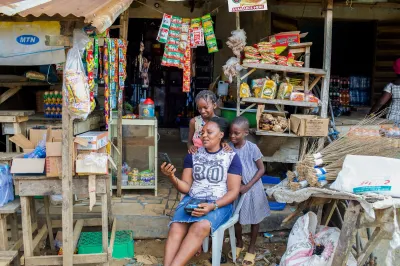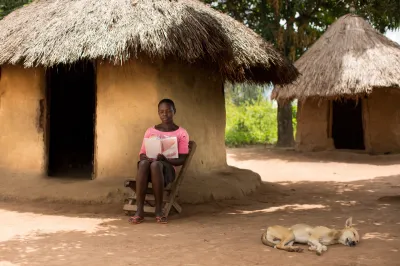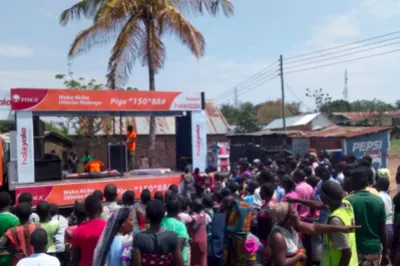Interactive SMS Drives Digital Savings and Borrowing in Tanzania
For anyone who has ever stood in front of a classroom after delivering a lesson, the question “what did they learn, and what difference will it make?” has surely come to mind.
In many cases, this is a black box, including when it comes to traditional financial education, where in-person trainings are often delinked from the desired actions consumers will take – they may learn about interest rates now, but won’t need to borrow for a few months, or even years. This may be why recent analysis (see, for example, Fernandes [2014]) has questioned the behavioral change that traditional financial education programs can have.
But what if you could deliver the learning content at the moment in time it is most needed, and directly monitor not only how the content was accessed but its subsequent impact on actual financial behavior?
This was the premise behind an interactive SMS project for users of M-Pawa, Vodacom and Commercial Bank of Africa’s fully digital mobile money savings and credit product. The platform was run by Arifu, a personalized learning tool that provides customized learning content based on consumers’ preferences and responses. The project targeted farmers in rural Tanzania, as part of the Connected Farmers Alliance, who were receiving in-person trainings.
Using the farmers’ own feedback from initial user testing, CGAP, Arifu, TechnoServe, Vodacom and the Busara Centre for Behavioral Research developed a series of interactive SMS scripts that let farmers guide their own learning on their phones, and to do so when they wanted and on the content they wanted.
For example, those more interested in loans could learn how to check their loan limit or how to use a cost calculator tool; while those interested in savings could read a story of a farmer like them who saved on M-Pawa for their business or set their own personal savings goal.
The team also tested a range of different types of behavioral messages to drive uptake of the SMS content and different learning approaches – narrative, facts, introducing the Arifu name in the SMS as a personal learning guide to increase personalization of the experience – to see which messages worked best.
Overall, the results for the six-month pilot were striking. A total of 33,782 invitations was sent to farmers. The 2,862 farmers who accessed the Arifu learning platform saved at rates more than five times those of farmers who did not access the learning platform.

Similarly, farmers who accessed the Arifu learning content – regardless of the specific delivery method – took out larger loan amounts and repaid at higher rates than those who did not access the learning content.

On average, the more screens a farmer viewed, the more financial activity they had on M-Pawa. Even more interesting still, the treatment that introduced Arifu as their learning guide from the beginning had the highest impact on financial behavior – as shown in the graph on loan amounts. This shows how personification can help amplify digital learning. During pilot testing of SMS content with farmers, several farmers inquired about Arifu, asking questions such as “Arifu nii nani?” (Who is Arifu?) and frequently assuming it was another person communicating with them.
Besides the evidence this research provides on the power of timely, user-guided digital learning content, the research also highlights two key principles for consumer protection and responsible delivery of digital finance.
First, the use of well-built, interactive content about product features – including costs – helped increase use of the product and positive financial outcomes. While we have noted in the past how many digital lenders offer poor or insufficient disclosure of terms, these findings show how robust disclosure can be a good thing for providers as well as consumers (something also documented in CGAP’s digital credit experiment with Jumo in Kenya.)
Second, the interaction between the savings and borrowing aspects of M-Pawa in this experiment show how important it is to offer not only credit, but a place to store value. By driving up savings on M-Pawa, farmers were able to more accurately share their cash flow, and receive larger, more accurate loan amounts, leading to larger amounts borrowed and higher repayment rates for those who accessed the Arifu learning content.
We hope these results demonstrate the utility of enhanced consumer engagement, and that we see more approaches like this by digital financial service providers in the future, leading to increased consumer understanding, product use and benefit for consumer and provider alike.
A supplementary paper can be found here.




Comments
Educating customers is key
Educating customers is key and very interesting to see this is digitized as well. Customer/Product appropriateness is a financial regulation for mainstream banking customers, which is built on the fundamentals of explaining the product and educating customers on the risks and benefits. Hope to see countries adopting similar regulations more broader extending to the bottom of the pyramid, without necessarily increasing the cost of service provided.
Relevance of the service
Relevance of the service/product and education of know how are the important variable to see the successes while farmers, low income & less educated customers are the target. Let's try with interactive voice conversation. Hope it will give different result. Thanks
Hi Rafe,
Hi Rafe,
There might be some causality confusion here on the impact of the SMS messages:
Are you sure the customers who decided to use the platform weren’t already going to save a lot? And thus they were interested in using the platform?
Similarly, do you know what the financial activity rate of platform users was before they started using the platform? How do you know it changed as a result of using the platform and wasn’t already high or wouldn't have been high absent the platform?
Best,
MacGregor
I had the same reaction! If
I had the same reaction! If there is a full impact assessment report, with more detail on methodology, it would be very useful to see a link to that. It can be difficult to find rigorous evidence related to financial capability interventions, so the more information we can share, the better.
As I said in another comment
As I said in another comment on M-Pawa financial education and marketing are the best option for long term healthy effect on Financial Inclusion, although I am preaching from 30 years back to use the Internet and the Multimedia, it is now that I had news that a group (ARIFU) is doing it, making me very happy. As I commented in another post in this blog, back in the 70s I was well involved in the so-called “bankarization” at that time in Brazil (Now called Financial Inclusion) by the Housing Savings and Loan Associations. At that time, we did not have Internet nor did we had easy access to communications as today. However, 700 private Savings and Loan Associations partnered with the public Housing Central Bank to create the “Centre for Savings Promotion”, this institution started nation wide advertising campaigns to promote the opening of a Savings Passbook (Caderneta de Poupanza) and devise distance training courses on financial education. We used synchronized sound with slides projectors in all the institutions to teach finances, giving distance training booklets to be filled and sent back to be punctuated and give a passbook, with a small initial deposit, as a prize to those who successfully ended the course. Well, Brazil today has an 85% of financial included, compared to the rest of Latin America with 52%, nearly half of that of Brazil. It is very motivating for me to think I put at that time, my sand grain.
If we see the first graphic, there is a similar proportion between the difference in savings, between the farmers that assisted to the ARIFU platform with out any doubt those in the this platform save much more, this matches the results obtain back in the 70s in Brazil. On the other hand, as it is quoted in the post:” This shows how personification can help amplify digital learning”. I also found in Brazil that the facilitator was an important factor in the learning recipe. Being the reason to use the sound synchronized slide projectors in the Savings and Loan Associations premises, were every hour, a 15 minute meeting was held with the interesting parties. The meeting was to give them an overview of the savings passbook advantages and to teach them use the distant learning booklet. Today, I am giving training all over the World from Madrid using a virtual classroom that I developed that runs in computers, tablets and mobile phones. This solution could also be developed by ARIFU using a call centre and trained university students working part time, according to their classes to attend brief consultations from people that have been previously trained to use their platform. As a marketing expert that has work in Microfinances for many years. ARIFU could even, if they make agreements with interested farm articles providers, to create a discount club (As I did in many MFI, to benefit their clients) that will give discounts to the farmers and a commission to ARIFU to cover the operational costs of the service.
Jose,
Jose,
This is a detailed and inspiring story. It is interesting to hear what the technology innovations were at that time, and how what seems out-dated now was still very effective in its context of the time period.
You mentioned the trainer is a key variable to effectiveness, and I wonder what digital learning content gains and loses from the in-person element. We can be more standardized in quality, but there isa certain "magic" good trainers possess I think we can't truly replicate digitally.
Rafe
Thank you both for bringing
Thank you both for bringing up the selection bias point. (And apologies for my delay in reply, I've been away from the office.)
I think we have a combination of both behavior change and selection bias. We are drafting a working paper where we took these participants' transaction records from 2014 through May 2016, and do see an increase in activity within individual accounts as well as treatment versus control. The analysis is not finished, so I can't say that this explains all the effect--hence my agreement there is a bit of selection bias at play. But it does make me confident this does have an impact outside of selection bias and reverses dormancy or low activity of those who have potential to be big savers on M-Pawa. Send an email if you want to dive into this in more detail.
Add new comment